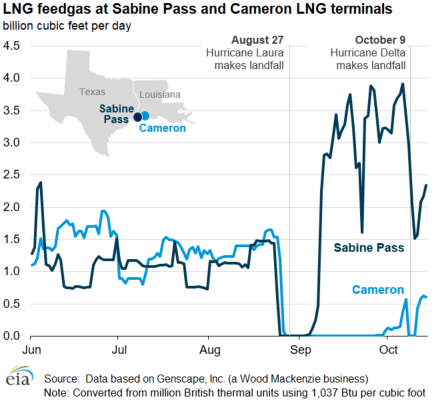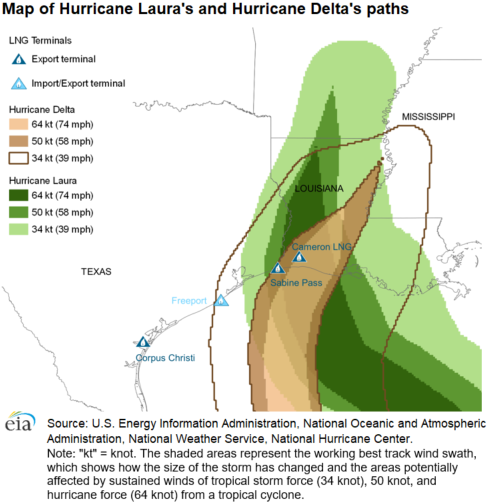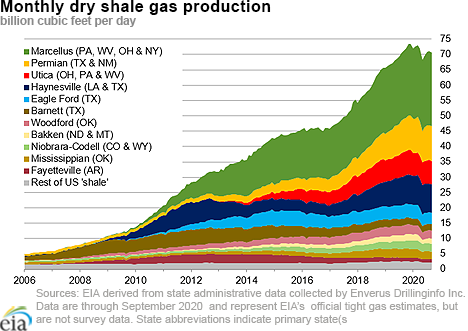In the News:
Hurricane Delta’s impacts on U.S. LNG export facilities are minimal
Six weeks after Hurricane Laura made landfall near Cameron, Louisiana, another hurricane—Hurricane Delta—made landfall as a Category 2 storm in the same region in southwest Louisiana, 40 miles from the Cameron LNG liquefied natural gas (LNG) export terminal. This year’s hurricane season has been the second most active Atlantic hurricane season on record, with 25 named storms. Almost 90% of U.S. LNG export capacity is located in the Gulf of Mexico—the area frequently affected by hurricane activity. Cameron LNG was in the main path of Hurricane Delta and implemented a controlled shutdown, but because it did not lose electric power, it was able to restart LNG production two days later on October 11, 2020. Sabine Pass LNG terminal continued operations during Hurricane Delta, ramping up deliveries to 2.1 billion cubic feet per day (Bcf/d) on October 12, 2020, according to data provided by Genscape, Inc. (a Wood Mackenzie business).
After Hurricane Laura, Cameron LNG remained offline from August 27 through September 26. Approximately one month later, the terminal resumed receiving small amounts of natural gas, ramping up deliveries to an average of 0.6 Bcf/d since October 13. After the waterways around Cameron LNG, including the Calcasieu Ship Channel, were cleared of debris, allowing passage of large LNG vessels, Cameron LNG shipped its first post-Hurricane Laura cargo on October 5, 2020. This cargo was loaded with LNG stored in the terminal’s LNG storage tanks. Following Hurricane Delta, the Calcasieu Ship Channel is undergoing a post-hurricane damage assessment and remains full of debris that has to be cleared before passage of deep draft vessels can resume.
The Sabine Pass LNG terminal remained in operation as Hurricane Delta approached and had a ride-out crew onsite during the storm. On October 11, 2020, two days after Hurricane Delta’s landfall, U.S. Coast Guard re-opened the Sabine Neches Waterway—the location of the Sabine Pass LNG terminal—with some restrictions on the draft of vessels. Draft of loaded LNG vessels depends on LNG-carrying capacity of the vessel and the volume of loaded LNG. The LNG-carrying capacity of LNG vessels that have been loading at the Sabine Pass LNG terminal during the past four years ranged from 2.9 billion cubic feet (Bcf) to 4.8 Bcf, and the draft of these vessels when loaded ranged from 31.8 feet to 37.7 feet, according to shipping data provided by Refinitiv Eikon. Since re-opening of Sabine Neches Waterway, three LNG vessels with LNG-carrying capacity of 3.8 Bcf (loaded draft 35.4 feet), 3.3 Bcf (loaded draft 36.4 feet) and 3.5 Bcf (loaded draft 37.4 feet) have departed the Sabine Pass LNG terminal.
Natural gas feedstock deliveries to all six U.S. LNG export terminals increased to 7.5 Bcf/d on October 12−14, 2020. Cove Point LNG, which was shut down for a scheduled annual maintenance since September 22, came back online on October 12, and its LNG feedgas deliveries averaged 0.7 Bcf/d, or 100% of its baseload capacity.
Overview:
(For the week ending Wednesday, October 14, 2020)
- Natural gas spot prices rose at most locations this report week (Wednesday, October 7 to Wednesday, October 14). The Henry Hub spot price remained flat at $2.03 per million British thermal units (MMBtu).
- At the New York Mercantile Exchange (Nymex), the price of the November 2020 contract increased 3¢, from $2.606/MMBtu last Wednesday to $2.636/MMBtu yesterday. The price of the 12-month strip averaging November 2020 through October 2021 futures contracts climbed 8¢/MMBtu to $3.000/MMBtu.
- The net injections to working gas totaled 46 billion cubic feet (Bcf) for the week ending October 9. Working natural gas stocks totaled 3,877 Bcf, which is 11% more than the year-ago level and 10% more than the five-year (2015–19) average for this week.
- The natural gas plant liquids composite price at Mont Belvieu, Texas, rose by 23¢/MMBtu, averaging $5.05/MMBtu for the week ending October 14. The prices of ethane, propane, natural gasoline, butane, and isobutane all rose, by 4%, 4%, 5%, 6%, and 8%, respectively.
- According to Baker Hughes, for the week ending Tuesday, October 6, the natural gas rig count decreased by 1 to 73. The number of oil-directed rigs rose by 4 to 193. The total rig count increased by 3, and it now stands at 269.
Prices/Supply/Demand:
Prices rise at most locations across the Lower 48 states with warmer-than-normal temperatures. This report week (Wednesday, October 7 to Wednesday, October 14), the Henry Hub spot price remained flat, starting and ending the report week at $2.03/MMBtu after briefly reaching a low of $1.48/MMBtu on Thursday. Temperatures were generally warmer than normal across most of the Lower 48 states. At the Chicago Citygate, the price increased 50¢ from $1.58/MMBtu last Wednesday to a high of $2.08/MMBtu yesterday.
PG&E shuts off power in targeted areas of California because of wildfire risk. On Wednesday night, Pacific Gas and Electric Company (PG&E) shut off power to certain areas of 24 counties in Northern and Central California, affecting 53,000 electric and natural gas customers. PG&E announced that they issued the shut off because of a, “high-wind event combined with low humidity and severely dry vegetation that together create high risk of catastrophic wildfires.” As of yesterday, Cal Fire reported that firefighters are battling more than 13 major wildfires, and several smaller ones. The power shut off is expected to continue in some areas through Friday morning, according to PG&E’s press release.
California prices rise amid PG&E power shut offs. The price at PG&E Citygate in Northern California rose 14¢, up from $3.97/MMBtu last Wednesday to $4.11/MMBtu yesterday. The price at SoCal Citygate in Southern California increased $1.47 from a low of $2.91/MMBtu last Wednesday to $4.38/MMBtu yesterday, after reaching a high of $5.78/MMBtu on Tuesday. The higher prices at SoCal Citygate coincide with warm temperatures in Southern California late in the report week and a force majeure declaration by El Paso Natural Gas on October 11 at the Topock Compressor Station, located near the California/Arizona border.
Prices in the Pacific Northwest rise with a force majeure. The price at Sumas on the Canada-Washington border rose $1.64 from $2.45/MMBtu last Wednesday to a high of $4.09/MMBtu yesterday. Prices were high at the end of the week amid a force majeure at a compressor station on the Gas Transmission Northwest (GTN) pipeline at the Kingsgate border crossing point in Eastport, Idaho. The force majeure will be lifted for natural gas day October 16.
Northeast prices are up. At the Algonquin Citygate, which serves Boston-area consumers, the price went up 12¢ from $1.44/MMBtu last Wednesday to a high of $1.56/MMBtu yesterday after reaching a low of $0.82/MMBtu on Thursday. At the Transcontinental Pipeline Zone 6 trading point for New York City, the price increased 12¢ from $1.15/MMBtu last Wednesday to $1.27/MMBtu yesterday.
The Tennessee Zone 4 Marcellus spot price decreased 7¢ from $1.10/MMBtu last Wednesday to $1.03/MMBtu yesterday. The price at Dominion South in southwest Pennsylvania fell 3¢ from $1.13/MMBtu last Wednesday to $1.10/MMBtu yesterday.
Permian Basin prices fall, widening the discount to the Henry Hub. The price at the Waha Hub in West Texas, which is located near Permian Basin production activities, averaged $0.45/MMBtu last Wednesday, $1.58/MMBtu lower than the Henry Hub price. Yesterday, the price at the Waha Hub averaged a low of $0.05/MMBtu, which was $1.98/MMBtu lower than the Henry Hub price, amid maintenance on the El Paso Natural Gas pipeline.
Supply falls. According to data from IHS Markit, the average total supply of natural gas fell by 1.7% compared with the previous report week. Dry natural gas production decreased by 1.4% compared with the previous report week. Average net imports from Canada decreased by 7.1% from last week; imports were reduced by an estimated 0.2 Bcf/d at the Eastport border crossing point in Idaho because of the force majeure on the GTN pipeline.
Demand falls, driven by declines in building usage. Total U.S. consumption of natural gas fell by 3.5% compared with the previous report week, according to data from IHS Markit. Natural gas consumed for power generation climbed by 2.3% week over week. In the residential and commercial sectors, consumption declined by 17.1% amid warmer temperatures compared to last week. Industrial sector consumption decreased by 3.2% week over week. Natural gas exports to Mexico increased 7.5%.
Natural gas deliveries to U.S. liquefied natural gas (LNG) export facilities (LNG pipeline receipts) averaged 6.6 Bcf/d, or 0.7 Bcf/d lower than last week. A force majeure on the Creole Pipeline Trail that feeds the Sabine Pass LNG facility has been in effect since Monday, reducing flows to the terminal by an estimated 1.5 Bcf/d, according to Natural Gas Intelligence.
U.S. LNG exports decline week over week. Twelve LNG vessels (four each from Sabine Pass and Freeport, three from Corpus Christi, and one from Elba Island) with a combined LNG-carrying capacity of 42 Bcf departed the United States between October 8 and October 14, according to shipping data provided by Marine Traffic.
The Army Corps of Engineers reported that a barge sank in the Calcasieu Ship Channel on Tuesday night. The barge is one of three obstructions that must be cleared before large draft vessels can access the Cameron LNG facility and transit the channel. Bloomberg data show that a vessel is waiting to dock at Cameron. The U.S. Coast Guard will determine when deep draft traffic can resume in the channel.
Storage:
The net injections into storage totaled 46 Bcf for the week ending October 9, compared with the five-year (2015–19) average net injections of 87 Bcf and last year's net injections of 102 Bcf during the same week. Working natural gas stocks totaled 3,877 Bcf, which is 353 Bcf more than the five-year average and 388 Bcf more than last year at this time.
According to The Desk survey of natural gas analysts, estimates of the weekly net change to working natural gas stocks ranged from net injections of 39 Bcf to 76 Bcf, with a median estimate of 51 Bcf.
The average rate of injections into storage is 2% higher than the five-year average so far in the refill season (April through October). If the rate of injections into storage matched the five-year average of 9. Bcf/d for the remainder of the refill season, the total inventory would be 4,076 Bcf on October 31, which is 353 Bcf higher than the five-year average of 3,723 Bcf for that time of year.
More storage data and analysis can be found on the Natural Gas Storage Dashboard and the Weekly Natural Gas Storage Report.
See also:
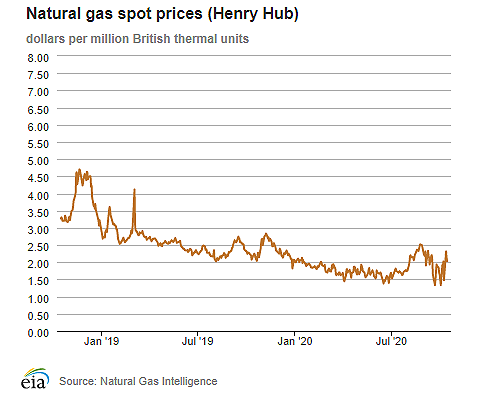
| Spot Prices ($/MMBtu) | Thu, 08-Oct |
Fri, 09-Oct |
Mon, 12-Oct |
Tue, 13-Oct |
Wed, 14-Oct |
|---|---|---|---|---|---|
| Henry Hub | 1.48 | 2.27 | 2.32 | 2.14 | 2.03 |
| New York | 0.66 | 0.60 | 1.25 | 1.24 | 1.27 |
| Chicago | 1.19 | 1.24 | 1.75 | 1.93 | 2.08 |
| Cal. Comp. Avg.* | 2.52 | 2.39 | 3.88 | 3.99 | 3.58 |
| Futures ($/MMBtu) | |||||
| November Contract | 2.627 | 2.741 | 2.881 | 2.855 | 2.636 |
| December Contract | 3.149 | 3.204 | 3.271 | 3.247 | 3.189 |
| *Avg. of NGI's reported prices for: Malin, PG&E Citygate, and Southern California Border Avg. | |||||
| Source: NGI's Daily Gas Price Index | |||||
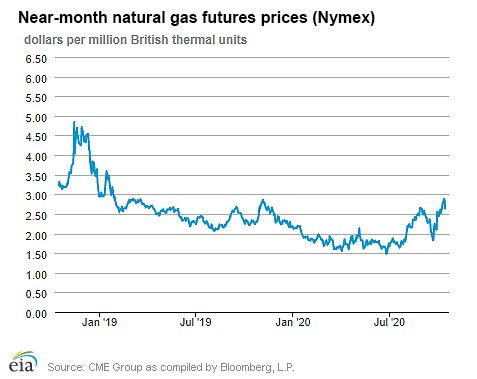
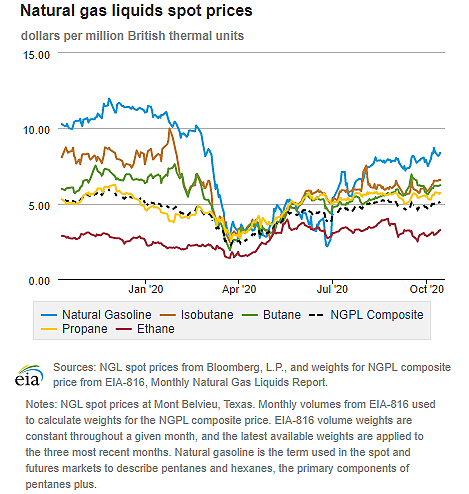
| U.S. natural gas supply - Gas Week: (10/8/20 - 10/14/20) | |||
|---|---|---|---|
Average daily values (Bcf/d): |
|||
this week |
last week |
last year |
|
| Marketed production | 97.2 |
98.6 |
106.3 |
| Dry production | 85.9 |
87.1 |
94.6 |
| Net Canada imports | 4.0 |
4.3 |
3.9 |
| LNG pipeline deliveries | 0.1 |
0.1 |
0.1 |
| Total supply | 89.9 |
91.5 |
98.6 |
|
Source: IHS Markit | |||
| U.S. natural gas consumption - Gas Week: (10/8/20 - 10/14/20) | |||
|---|---|---|---|
Average daily values (Bcf/d): |
|||
this week |
last week |
last year |
|
| U.S. consumption | 62.2 |
64.4 |
64.6 |
| Power | 30.4 |
29.7 |
29.8 |
| Industrial | 20.9 |
21.6 |
21.3 |
| Residential/commercial | 10.8 |
13.1 |
13.5 |
| Mexico exports | 5.9 |
5.5 |
5.7 |
| Pipeline fuel use/losses | 6.5 |
6.6 |
7.1 |
| LNG pipeline receipts | 6.6 |
7.3 |
6.5 |
| Total demand | 81.2 |
83.9 |
83.8 |
|
Source: IHS Markit | |||
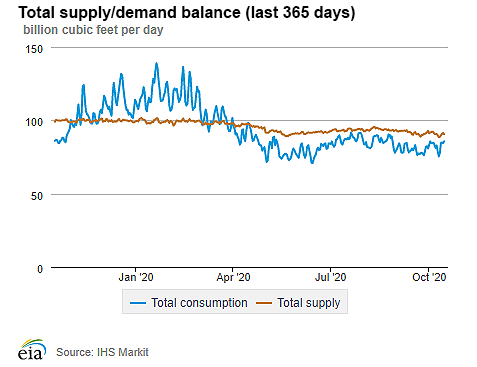
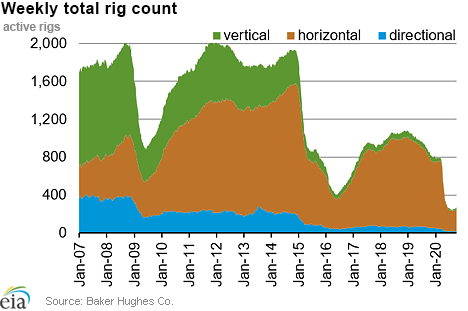
| Rigs | |||
|---|---|---|---|
Tue, October 06, 2020 |
Change from |
||
last week |
last year |
||
| Oil rigs | 193 |
2.1% |
-72.9% |
| Natural gas rigs | 73 |
-1.4% |
-49.0% |
| Note: Excludes any miscellaneous rigs | |||
| Rig numbers by type | |||
|---|---|---|---|
Tue, October 06, 2020 |
Change from |
||
last week |
last year |
||
| Vertical | 15 |
-6.3% |
-70.6% |
| Horizontal | 233 |
1.7% |
-68.9% |
| Directional | 21 |
0.0% |
-61.8% |
| Source: Baker Hughes Co. | |||
| Working gas in underground storage | ||||
|---|---|---|---|---|
Stocks billion cubic feet (Bcf) |
||||
| Region | 2020-10-09 |
2020-10-02 |
change |
|
| East | 908 |
893 |
15 |
|
| Midwest | 1,081 |
1,062 |
19 |
|
| Mountain | 241 |
236 |
5 |
|
| Pacific | 320 |
318 |
2 |
|
| South Central | 1,326 |
1,322 |
4 |
|
| Total | 3,877 |
3,831 |
46 |
|
|
Source: Form EIA-912, Weekly Underground Natural Gas Storage Report | ||||
| Working gas in underground storage | |||||
|---|---|---|---|---|---|
Historical comparisons |
|||||
Year ago (10/9/19) |
5-year average (2015-2019) |
||||
| Region | Stocks (Bcf) |
% change |
Stocks (Bcf) |
% change |
|
| East | 873 |
4.0 |
873 |
4.0 |
|
| Midwest | 1,034 |
4.5 |
1,011 |
6.9 |
|
| Mountain | 204 |
18.1 |
211 |
14.2 |
|
| Pacific | 296 |
8.1 |
313 |
2.2 |
|
| South Central | 1,082 |
22.6 |
1,116 |
18.8 |
|
| Total | 3,489 |
11.1 |
3,524 |
10.0 |
|
| Source: Form EIA-912, Weekly Underground Natural Gas Storage Report | |||||
| Temperature – heating & cooling degree days (week ending Oct 08) | ||||||||
|---|---|---|---|---|---|---|---|---|
HDD deviation from: |
CDD deviation from: |
|||||||
| Region | HDD Current |
normal |
last year |
CDD Current |
normal |
last year |
||
| New England | 65 |
-11 |
-16 |
0 |
0 |
0 |
||
| Middle Atlantic | 60 |
-4 |
2 |
0 |
-3 |
-1 |
||
| E N Central | 88 |
21 |
33 |
0 |
-4 |
-3 |
||
| W N Central | 79 |
13 |
8 |
4 |
-2 |
4 |
||
| South Atlantic | 36 |
5 |
25 |
32 |
-5 |
-30 |
||
| E S Central | 42 |
13 |
35 |
6 |
-16 |
-48 |
||
| W S Central | 14 |
6 |
10 |
37 |
-8 |
-38 |
||
| Mountain | 31 |
-35 |
-38 |
34 |
13 |
15 |
||
| Pacific | 4 |
-18 |
-17 |
44 |
29 |
35 |
||
| United States | 49 |
1 |
8 |
20 |
1 |
-7 |
||
|
Note: HDD = heating degree day; CDD = cooling degree day Source: National Oceanic and Atmospheric Administration | ||||||||
Average temperature (°F)
7-day mean ending Oct 08, 2020
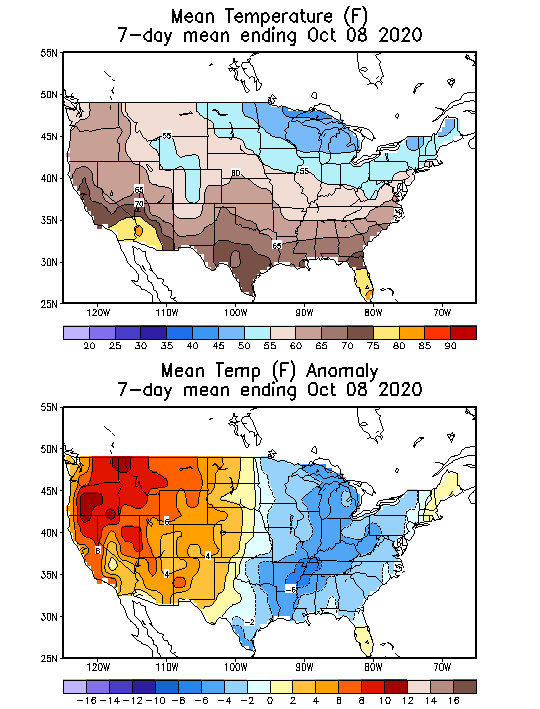
Source: National Oceanic and Atmospheric Administration
Deviation between average and normal (°F)
7-day mean ending Oct 08, 2020

Source: National Oceanic and Atmospheric Administration

